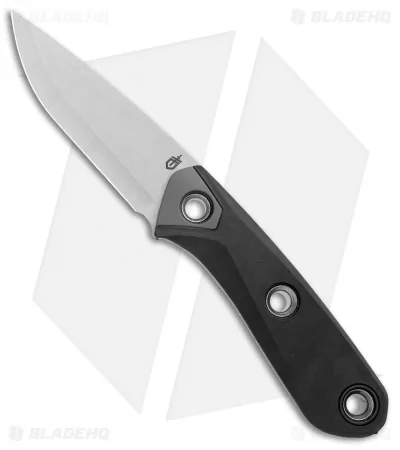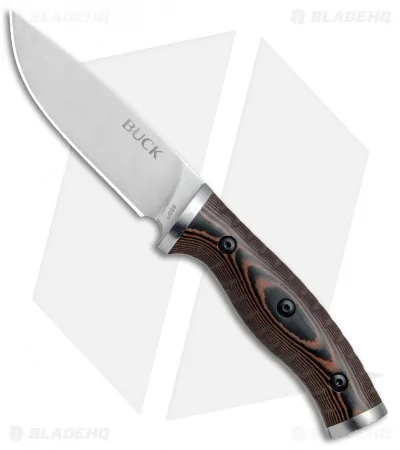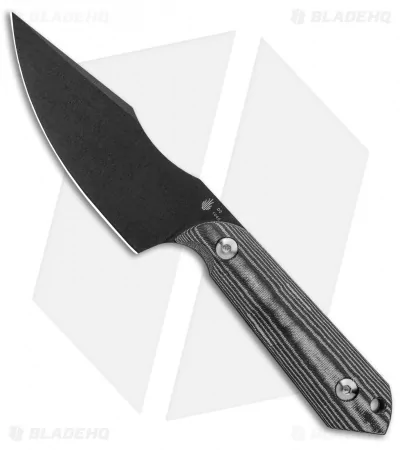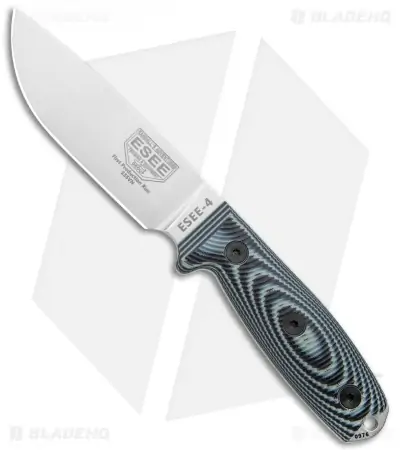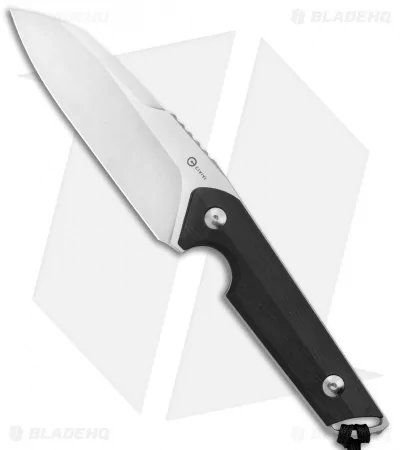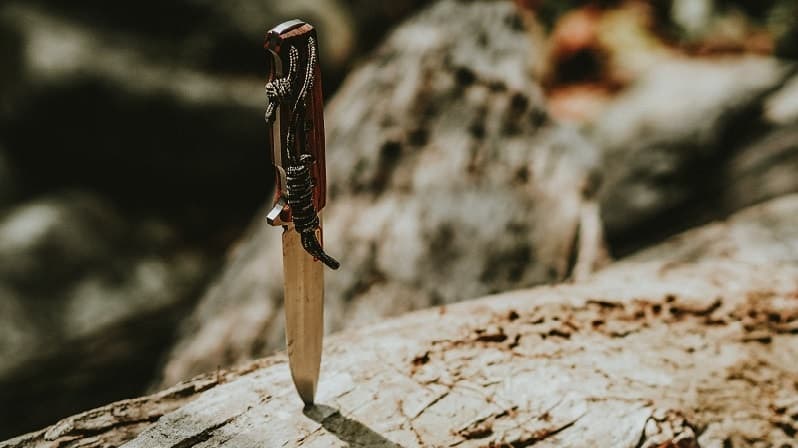
Looking around for alternatives to a pocket EDC, I discovered the horizontal carry knife. Also known as a scout carry knife, these knives can be carried horizontally on the belt, making them easily accessible, comfortable, and concealable.
We’ve focused exclusively on non-folding, full tang horizontal carry knives made from top-quality materials. We also prioritized those that were compact enough to carry horizontally without becoming too cumbersome.
Best All-Round
A compact and affordable bushcraft-style knife with a versatile sheath system.
Best Budget
Top 6 Horizontal Carry Knives Reviewed
#1 Gerber Principle
The Gerber Principle is a versatile knife based on the Gerber Ghoststrike, featured in our review of the best boot knives. The main difference is that the Gerber Principle has more of a bushcraft design.
Its small blade measures 3.10” long and is made of 420HC with a drop point and Scandinavian grind.
It’s strong and capable of performing numerous bushcraft and EDC tasks. The 420HC blade makes it easy to sharpen and stops the price from soaring, keeping it in a firmly affordable range.
Based on the traditional Finnish Puuko knife, the Gerber Principle is a functional all-rounder suited to every imaginable situation, from survival to opening a new delivery from BladeHQ!
The handle has a rubber grip that stops it from becoming slippery when wet. It’s designed to be held using any primary grip, including baseball and precision.
The only downside is that the sheath is a little loose, but you can heat it to improve the friction on the blade.
The versatile sheath system means you can carry the Gerger Principle vertically or horizontally. If neither of those floats your boat, then you can take advantage of its MOLLE compatibility and attach it to your bug-out bag instead.
Pros:
- 3.10” 420HC drop point blade
- Adaptable sheath system
Cons:
- Sheath could be tighter
#2 Schrade Fixed Blade Full Tang
Costing less than half the price of our other horizontal carry knives, the Schrade fixed blade delivers a lot of bang for its buck. It has a full tang fixed blade with a drop point, a handle made of a durable composite of fiberglass and epoxy resin, and a Kydex sheath.
Rugged and resilient, it has a series of notches or jimps down the blade’s spine to improve your grip and give you better control when cutting.
Although it may not feature the toughest metal, the Schrade is nevertheless a solid knife that’s more than capable of performing basic bushcraft tasks. Make sure you know how to sharpen it before heading out into the woods!
The blade is relatively small, measuring just 2.6in, while the knife is pleasantly compact at 6.3in. This makes it easy to conceal and more comfortable for those of us with smaller hands.
The sheath comes set for vertical carry, but the Phillips head screws are easy to loosen, so you can easily adapt it to horizontal carry.
Pros:
- Compact knife with full tang drop point blade
- The rugged handle provides a secure grip
Cons:
- The metal blade could be stronger
- May need regular resharpening
#3 Buck Small Selkirk Fixed Blade Knife Micarta
Like its big brother, the Buck 863 Selkirk, the Buck Small Selkirk is a durable and dependable bush knife and camping tool.
Its 420 HC steel blade measures 3.875” long, with a cutting blade of 3.7”. It is full tang and therefore durable enough for the most challenging survival situations, while the drop point makes it difficult to snap.
There’s very little this knife can’t do in terms of taming the outdoors, and its contoured handle means it’s easy to control whatever the task.
The multi-position sheath can be set up for left or right-handed horizontal carry, although figuring out how to set it up might take a while.
Although we’d like to see this knife with a carbon steel blade, we wouldn’t enjoy the inevitable price increase. As it stands, this versatile and capable knife represents excellent value for money.
Pros:
- Full tang, drop point 420 steel blade
- Contoured handle for better control
Cons:
- Sheath is challenging to adjust
- Blade could be more durable
#4 Kizer Maverick Customs Harpoon Fixed Blade Knife Micarta
The highly-rated Kizer Harpoon has a D2 steel blade, making it more durable than many horizontal carry knives. It also has a black powder coating that improves its corrosion resistance.
The Kizer Harpoon is one of the few with a sheath system specifically designed for scout carry. As a result, you can easily change from right, or left-handed scout carry to right or left-front horizontal carry without even taking it off your belt.
While versatile, the sheath isn’t as snug as it could be. You can tighten it up by heating the Kydex sheath, but we’d prefer to see it upgraded with the introduction of a couple of tension screws.
Pros:
- The adjustable horizontal sheath system
- Corrosion-resistant blade
Cons:
- Sheath could be improved with tension screws
#5 ESEE Knives ESEE-4 Fixed Blade Knife 3D
This is one of the more powerful and robust items on our list, but it also comes with a premium price tag.
Instead of the standard 420 HC steel, the ESSE-4 features a CPM-S35VN stainless steel blade. With its high Rockwell Hardness Rating (HRC) rating, S35VN steel is highly durable and corrosion-resistant.
The handle of this fixed blade knife is comfortable and provides a secure grip even in wet conditions.
The molded polymer sheath is easily adjustable. The clip section has holes in each corner, making it easy to switch between vertical and horizontal carry positions.
Designed as a versatile survival and bushcraft knife, the ESEE-4 is durable and hard-wearing. A little larger than some of our other horizontal carry knives, it measures 9” in total. The drop point blade is 4.5” long with a cutting edge of just over 4”.
Like all ESEE knives, it comes with a lifetime guarantee which should make parting with such a large wad of cash somewhat less painful.
Pros:
- CPM-S35VN stainless steel blade
- Versatile sheath
Cons:
#6 CIVIVI Kepler Fixed Blade Knife Black G-10
The largest of all the scout carry knives we reviewed, at 10” long, the CIVIVI is a little too long for smaller people like myself. It is nevertheless a robust and functional tool that will more than do the job on a camping trip or in a survival situation.
The 4.5” blade is made of 9Cr18MoV – a type of high carbon steel approximately equivalent to the 440C. It’s also corrosion-resistant and features deep jimping along the spine for greater precision and control.
Ideal for preparing food and starting fires, its Wharncliffe shape also makes it handy in a self-defense situation.
The handle’s a little on the thin side but comfortable enough in the hand, thanks to its ergonomic design. It also has a deep finger choil to prevent it from twisting.
The Civivi comes with a sheath and T-clip based on the Tek Lok design, making it simple to adjust to either left or right-handed horizontal carry.
Pros:
- Ergonomic design provides good control
- Durable, corrosion-resistant blade
Cons:
- Too large for small hands
How to Select the Best Horizontal Carry Knife
I’d feel comfortable carrying any of the knives reviewed here, based on the following criteria:
Style
All these knives are small enough to be carried horizontally without restricting movement. They are easy to conceal and versatile enough to be used for bushcraft tasks or as an EDC knife.
While the ESEE-4 is arguably more suited to survival, the CIVIVI Kepler is better for self-defense, while the Gerber Principle is the most versatile.
Materials
Blade
A high-quality steel blade is the first thing to look for in any knife. It gives you the durability and corrosion resistance you need in a survival situation and won’t require frequent sharpening.
Unfortunately, the better the blade, the higher the price. The Gerber Principle treads the fine line between affordability and durability better than most, while the Schrade is surprisingly rugged given its price tag.
Handle
The handle is just as important as the blade and should provide a secure grip regardless of external conditions or how you choose to hold the knife.
The best horizontal carry knives feature Micarta or G-10, complete with jimps or notches that improve your hold. Unlike rubber grips, they can handle a lot of abuse without perishing.
Blade Shape
Drop point blades are the most common among horizontal carry knives and provide as much stabbing power as they do cutting capability.
The Wharncliffe design of the CIVIVI Kepler makes it more suited to self-defense while providing strength and stability. On the downside, they lack the stabbing abilities of the drop point.
Size
A more compact knife is easier to conceal and more comfortable to carry. It won’t snag on branches while you’re hiking and is less likely to jab you in the ribs.
The ideal blade length for a scout carry knife is between 3.5” and 4” long. In other words, it’s long enough to perform various tasks without becoming overly cumbersome.
For those of you who have relatively small hands, a knife as large as the CIVIVI Kepler becomes a little unwieldy.
Cost
While it’s worth investing in a good-quality knife that won’t break on you, you also don’t want to break your bank balance when purchasing it. If you decide that nothing but the best will do, it’s time to start saving up for something like the ESEE-4.
However, if you’re prioritizing value for money, the Gerber Principle or Buck Small Selkirk is a better choice. For those on a tight budget, the Schrade is a good budget option that won’t let you down in a survival situation.
Conclusion
We’ve selected the Gerber Principle as our top choice based on its balance between quality and affordability. It’s hard-wearing and durable yet compact enough for small hands.
The Schrade is a surprisingly good quality knife given its budget price tag but will never be able to compete with premium choices like the ESEE-4.


